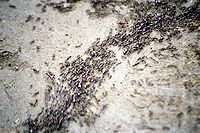
Photo from wikipedia
In the present study, nanocrystalline cellulose (NCC) was prepared via acid hydrolysis and synthesis parameters were optimized via response surface modelling with a determined maximum NCC yield of 43.8%. The… Click to show full abstract
In the present study, nanocrystalline cellulose (NCC) was prepared via acid hydrolysis and synthesis parameters were optimized via response surface modelling with a determined maximum NCC yield of 43.8%. The optimized NCC sample was subsequently surface modified via epichlorohydrin-mediated amination forming aminated nanocrystalline cellulose (A-NCC) with an amine content calculated as 1500μmol/g. The average particle size and zeta potential were determined 100nm and 325nm for NCC and A-NCC, respectively. Structural properties were analyzed by FTIR, TEM and XRD techniques. The obtained A-NCC as final product depicted a pKa value of 10.86±0.07 demonstrating favourable protonation of amine groups at physiological pH allowing the material to be suitable for prospective application in drug delivery and tissue engineering.
Journal Title: International journal of biological macromolecules
Year Published: 2018
Link to full text (if available)
Share on Social Media: Sign Up to like & get
recommendations!